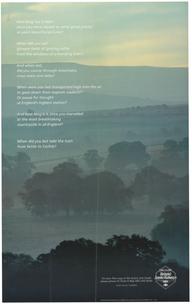

Die erste Eisenbahn in Deutschland (The first railway in Germany)
- artist:
- Heintz Heim
Poster, "Die erste Eisenbahn in Deutschland. Abfahrt des Eroffnungszuges von Nurnberg nach Furth am 7 Dezember 1835." Reproduction copy made in 1986 of a late nineteenth century coloured lithograph by Heinrich Heim, preserved by the German Railway Museum at Nuremburg. It depicts the ceremonial departure of the first passenger train in Germany, hauled by the locomotive "Der Adler" (The Eagle) on 7 December 1835.
This poster depicts Germany's first passenger railway. The title, "Die erste Eisenbahn in Deutschland. Abfahrt des Eroffnungszuges von Nurnberg nach Furth am 7 Dezember 1835" means "The first railway in Germany. Departure of the opening train from Nuremberg to Furth on 7 December 1835".
The poster is a copy, printed in 1986, of a coloured print made in the late nineteenth century and based on a painting by the artist Heinrich Heim. The original is in the DB Museum in Nuremberg.
Germany's first railway ran just 6 kilometres between Nuremberg and Furth. It was named the Ludwig Line after King Ludwig I of Bavaria. The first train carried 200 invited passengers and was hauled by the locomotive 'Der Adler' ('The Eagle') which had been designed and built in Newcastle by the father and son, George and Robert Stephenson.
Despite the poster's claim, the Ludwig Line wasn't quite the first in Germany. The Royal Prussian Steelworks had built and trialled a locomotive in 1816, but it never ran commercially.
Details
- Category:
- Railway Posters, Notices & Handbills
- Object Number:
- 2003-8834
- Materials:
- ink and paper (fibre product)
- Measurements:
-
: 24.8031 x 35.0394 in.; 630 x 890 mm
- type:
- poster
- credit:
- German Railway Museum




